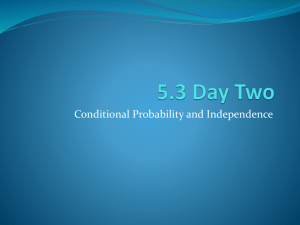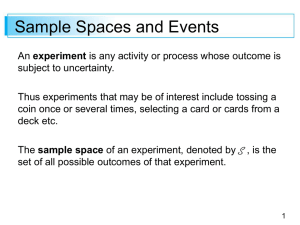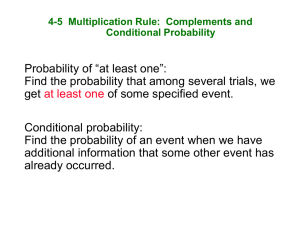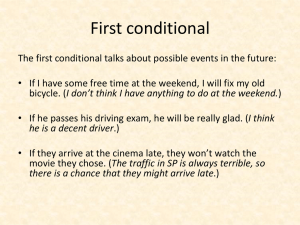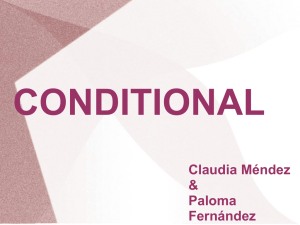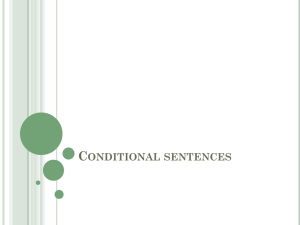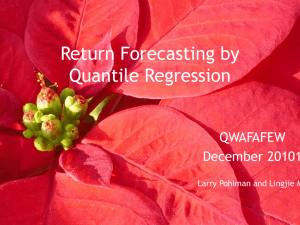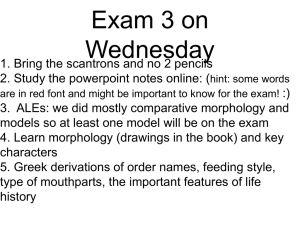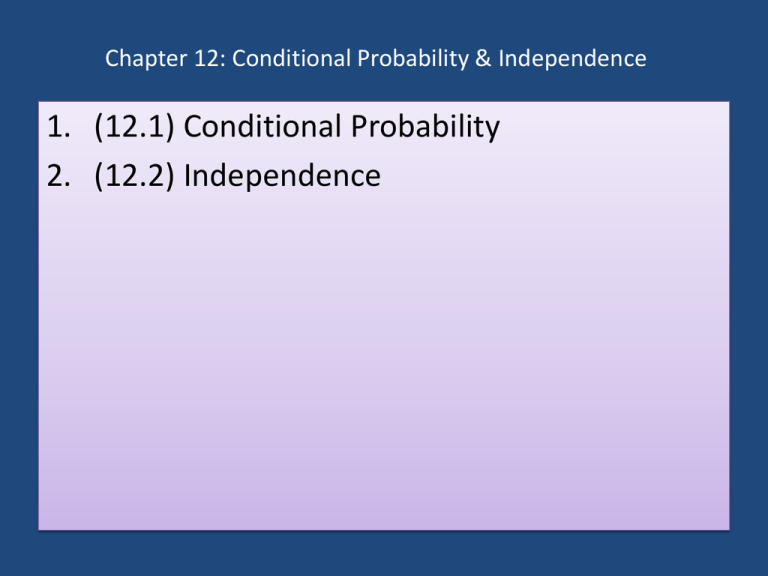
Chapter 12: Conditional Probability & Independence
1. (12.1) Conditional Probability
2. (12.2) Independence
1. (12.1) Conditional Probability
Motivating Example
•
•
•
•
In this chapter we explore finding the probability of an
event given certain conditions or prior information.
For example, consider the experiment of rolling two dice.
The probability of the event A = “sum of 6” is easy to find:
A {15, 24, 33, 42, 51} 5
P ( A) = =
=
S
S
36
Suppose, however, that you roll two dice and you don’t look
at them. I tell you that you rolled doubles. Now what is the
probability that the sum is 6?
Solution: Let event A = “sum of 6” and B = “rolled doubles.”
We now want to know the probability of event A given
event B. Intuitively, we expect that the answer should be
1/6 since there are six ways to roll doubles and only one of
them sums to 6.
1. (12.1) Conditional Probability
Definition: Conditional Probability
•
Let B be an event with P(B) > 0. Then we define the
conditional probability of event A given B by:
P ( AB) =
•
P ( A Ç B) (area of R ) (area of S) area of R
=
=
P ( B)
(area of B) (area of S) area of B
Heuristically, consider the diagram below and adopt the
“dartboard” point of view described in Chapter 12:
R
Given that event B has occurred,
we know that our “dart” has landed
somewhere in B. Thus, the probability
that it also landed in A is the area of
the shaded region, R, divided by the
area of rectangle B.
1. (12.1) Conditional Probability
Motivating Example (Again)
•
•
Recall our solution for the motivating example: Let event A =
“sum of 6” and B = “rolled doubles.” Intuitively, we expect
that the the probability of A given B should be 1/6 since
there are six ways to roll doubles and only one of them
sums to 6.
We now check this against our definition:
{33} S
P ( A Ç B)
1 36 1
P ( AB) =
=
=
=
P ( B)
{11,22,33,44,55,66} S 6 36 6
1. (12.1) Conditional Probability
Example 12.1 (Tay-Sachs Disease)
•
•
•
Tay-Sachs disease is a serious disorder of the nervous
system that usually results in death by age 2 or 3. Affected
individuals have genotype tt, while normal (non-affected)
individuals have genotype Tt or TT.
Judy has a little brother with Tay-Sachs disease and is
worried she may carry the recessive allele. What is the
probability of this?
Solution: First, notice that both of Judy’s parents must be Tt
if her little brother has the disease. (We assume that neither
parent can be tt since they each lived to adulthood.)
1. (12.1) Conditional Probability
Example 12.1 (Tay-Sachs Disease)
•
•
The Punnett square gives the possible genotypes for Judy
without being given any other information:
Since Judy does not have the disease, we
eliminate the tt as a possibility. Looking at
the Punnett square, we intuitively guess
that the probability should be 2/3 . Let us show this is true
using the definition of conditional probability.
Let A = “Judy is Tt” and B = “Judy is not tt. Then,
{Tt,tT} S
P ( A Ç B)
24 2
P ( AB) =
=
=
=
P ( B)
{TT,Tt,tT} S 3 4 3
1. (12.1) Conditional Probability
Example 12.2 (Drug Testing)
•
•
A test for a new sleeping pill involved 200 individuals where
100 of the individuals were given the sleeping pill, and the
other 100 were given a sugar pill. The results of the test are
shown in the following table:
What is the probability that
if
you take the sleeping pill
you
will sleep better?
Solution: Let event A = “took sleeping pill,” and event B =
“slept better.” We want to find the probability that you will
sleep better given that you took the sleeping pill, i.e. P(B|A).
P ( B Ç A) B Ç A S
71 200
P (BA) =
=
=
= 0.71
P ( A)
A S
100 200
1. (12.1) Conditional Probability
Example 12.2 (Drug Testing)
•
What is the probability that
if
you slept better, you took
the sleeping pill?
Solution: (This is the converse of the previous question.) Let
event A = “took sleeping pill,” and event B = “slept better.”
Now we want to find P(A|B):
P ( A Ç B) A Ç B S
71 200
P ( AB) =
=
=
= 0.55
P ( B)
B S
129 200
1. (12.1) Conditional Probability
Some More Probability Laws: P(Ā|B)
•
Let A & B be events in S. Then,
P( A B) =1- P( A B)
•
The derivation is straightforward:
P ( A B) =
P ( A Ç B)
P ( B)
=
P(B Ç A)
P ( B)
P ( B) - P ( B Ç A)
=
P ( B)
P ( A Ç B)
= 1= 1- P ( A B)
P ( B)
Note, however, that this does
not work for the other
position. That is:
( )
P A B ¹1- P ( A B)
1. (12.1) Conditional Probability
Probability Law: P(A∩B)
•
Let A & B be events in S. If If P(B) ≠ 0 then,
P( A Ç B) = P ( A B) P ( B)
•
•
The derivation follows immediately from the definition of
conditional probability:
P ( A Ç B)
P ( A B) =
Þ P ( A Ç B) = P ( A B) P ( B)
P ( B)
Notice that since set intersection is commutative (that is,
A∩B = B∩A), we automatically get:
P( A Ç B) = P ( B A) P ( A)
1. (12.1) Conditional Probability
Example 12.3.a (Beetle Sampling without Replacement)
We have a population of 150 beetles. Thirty percent have wings
and the rest are wingless. You select a beetle at random and
record whether or not it has wings, and do not put it back.
Then you select another beetle.
What is the probability that the first and second beetle have
wings?
Solution: Let event A = “first beetle is winged,” and event B =
“second beetle is winged.” First we note that, at the start,
there are 0.3×150 = 45 winged beetles. Then:
P( B Ç A) = P ( B A) P ( A)
æ 44 ö æ 45 ö
=ç
÷×ç
÷ » 0.0886
è149 ø è150 ø
2. (12.2) Independence
Definition
Suppose the probability of some event is not affected by the
occurrence of another event. It seems natural in such a case
to consider these events independent of one another. We
formalize the notion:
We say events A and B are independent if P(A|B) = P(A).
Notice that, formally, if we swap the letters A & B in the
definition, we get P(B|A) = P(B). We should verify that this is
consistent with our definition for conditional probability:
Suppose that A and B are independent. Then,
P ( A Ç B)
P( A) = P ( A B) =
Þ P( A) P( B) = P( A Ç B)
P ( B)
P ( B Ç A)
We want to take special
= P( B A)
Þ P ( B) =
note of this relationship.
P ( A)
2. (12.2) Independence
Probability Law
•
Let A & B be independent events in S. Then,
P( A Ç B) = P ( A) P ( B)
•
Notice, when two events are mutually exclusive, the
probability of either/or event is the sum of the probabilities
of each event. However, when two events are independent,
the probability of both events occurring is the product of
the probabilities of each event:
P(A∪B)
P(A∩B)
Mutually exclusive
P(A) + P(B)
Æ
Independent
?
P(A) P(B)
2. (12.2) Independence
Mutually Exclusive & Independent?
•
•
•
•
Recall that if events A and B are mutually exclusive, then
P(A∩B) = 0. So if P(B) ≠ 0, then by the definition of
conditional probability we have:
P ( A Ç B)
P ( A B) =
=0
P ( B)
Now we ask, can events A and B be both independent and
mutually exclusive?
Suppose, they were then P(A|B) = P(A) and P(A|B) = 0, and
thus P(A) = 0. Furthermore, P(B|A) = P(B) and P(B|A) = 0,
and thus P(B) = 0.
Therefore, if events A and B are both independent and
mutually exclusive, then P(A) = 0 and P(B) = 0. That is,
events that are both mutually exclusive and independent
are only events with zero probability.
2. (12.2) Independence
Example 12.4
Two dice are tossed, one at a time. Let A = “6 on first die”, B = “sum of
7”, and C = “sum of 8”. Which events are independent? Which
events are mutually exclusive?
Solution:
B&C: Clearly, B and C are mutually exclusive with non-zero
probabilities, and therefore not independent.
To answer the question for A&B and A&C, we need the following
probabilities:
There are six possible outcomes on a die and only one way to roll
a 6. Thus, P(A) = 1/6 . In rolling two dice, there are 6 × 6 = 36
possible outcomes. There are six ways to get a “sum of 7”, {(16),
(25), (34), (43), (52), (61)}. Thus, P(B) = 6/36 = 1/6. There are five
ways to get a “sum of 8”, {(26), (35), (44), (53), (62)}. Thus, P(C) =
5/36. Event (A∩B) can only occur with a 6 on the first die and a 1
on the second die. Thus, P(A∩B) = 1/36. Event (A∩C) can only
occur with a 6 on the first die and a 2 on the second die. Thus,
P(A∩C ) = 1/36.
2. (12.2) Independence
Example 12.4
And we have the following:
P ( A Ç B) 1 36 1
A&B: P ( A B) =
=
= = P ( A)
P ( B)
6 36 6
Thus, A&B are independent (and not mutually exclusive.)
P ( A Ç C ) 1 36 1
A&C: P ( A C) =
=
= ¹ P ( A)
P (C)
5 36 5
Thus, A&C are not independent (and not mutually
exclusive.)
2. (12.2) Independence
When to Assume Independence?
When is it reasonable to assume independence? Some examples
relevant to our chapter:
1. Result of second sample is independent of first if first is
placed back into sampling pool.
2. Sex of second child is independent of first child.
3. Random selection of alleles on genes located on separate
chromosomes (Mendel’s Second Law of Independent
Assortment).
4. The genotypes of non-related individuals are independent
events.
2. (12.2) Independence
Example 12.5 (Beetle Sampling with Replacement)
Suppose we have a population of 150 beetles. Forty-five of the
beetles have wings and the rest are wingless. You select a
beetle at random and record whether or not it has wings,
and then put it back amongst the other beetles. Then you
select another beetle. Let events A = “first beetle has wings”
and B = “second beetle has wings”
What is the probability that (a) the first and second beetle have
wings? and (b) the first beetle has wings and the second
beetle does not have wings?
Solution:
(a) P( A Ç B) = P( A) P( B) = 0.3 ´ 0.3 = 0.09
(b) P( A Ç B ) = P( A) P( B ) = 0.3 ´ 0.7 = 0.21
2. (12.2) Independence
Example 12.6 (Blood Typing)
Suppose Jacob has O+ blood with genotype OO/Rr, and Anna has
B− blood with genotype BO/rr. What is the probability that a
child of Jacob and Anna will have (a) B+ blood, and (b) O−
blood?
Solution: We start by making a Punnett square for each gene:
Thus:
(a) P( B +) = P( B) P(+) = 0.5 ´ 0.5 = 0.25
(b) P(O -) = P(O) P(-) = 0.5 ´ 0.5 = 0.25
2. (12.2) Independence
Example 12.7 (Tay Sachs Disease)
This example uses both conditional probability and
independence.
Jack and Judy each had brothers afflicted with Tay-Sachs disease.
From Example 12.1, the probability of being a carrier if your
sibling has Tay-Sachs disease is 2/3. What is the probability
that Jack and Judy have a child with Tay-Sachs disease?
Solution: The only way the child can be tt is if Jack and Judy are
both Tt. Let events A = “Judy is Tt”, B = “Jack is Tt”, C = “child
is tt”. Thus:
(
)
(
)
P(C Ç ( A Ç B)) = P C ( A Ç B) P ( A Ç B) = P C ( A Ç B) P( A) P( B)
=
1 2 2 1
× × =
4 3 3 9
2. (12.2) Independence
Example 12.8 (Family Planning)
Assume the births of boys and girls are equiprobable and
independent. Let events A = “first child is a girl,” B = “second
child is a girl,” and C = “third child is a girl.” These are all
independent events.
(a) What is the probability that in a family with two children,
the children are both girls?
1 1 1
P ( A Ç B) = P ( A) P ( B) = × =
2 2 4
(b) What is the probability that in a family with three children,
the children are all girls?
1 1 1 1
P( A Ç B Ç C) = P ( A) P ( B) P (C) = × × =
2 2 2 8
2. (12.2) Independence
Example 12.8 (Family Planning)
(c) What is the probability that in a family with six children, the
children are all the same sex?
The probability that all six children are the same sex equals
the probability they are all boys plus the probability they are
all girls. Let events A1, A2, . . . , A6 be the events that the
first, second, . . . , sixth (respectively) child is a girl. Then:
P ( A1 Ç A2 Ç
Ç A6 ) = P ( A1 ) P ( A2 )
P ( A1 Ç A2 Ç
Ç A6 ) = P ( A1 ) P ( A2 )
1
1
1
P (all same sex) =
+
=
64 64 32
æ 1 ö6 1
P ( A6 ) = ç ÷ =
è 2 ø 64
6
æ 1ö
1
P ( A6 ) = ç ÷ =
è 2 ø 64
2. (12.2) Independence
Example 12.8 (Family Planning)
(d) What is the probability that in a family with six children,
there is at least one girl?
Let A = “at least one girl”. Then Ā = “no girls”, i.e. all boys.
Then:
P( A) = 1- P ( A ) = 1-
1 63
=
» 0.9844
64 64
Homework
Chapter 12: 1ab, 2, 4, 5, 6, 7, 9
Some answers:

